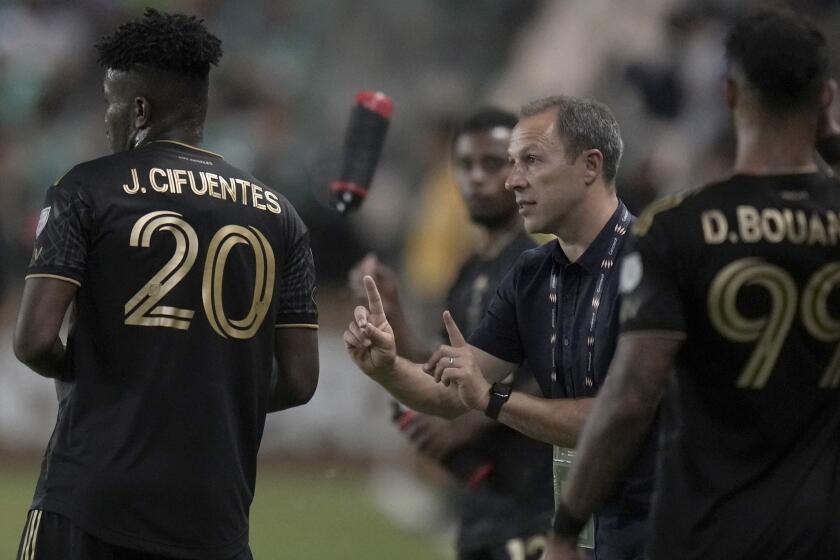Has MLS learned from the past?
- Share via
The North American Soccer League should have been entering its prime when it expired after 17 years, its life support mercifully unplugged after the 1984 season. An autopsy was never performed, but the suspected cause of death was greed, which fueled unchecked expansion and led to rosters chock-full of imports.
Major League Soccer kicked off its 17th season this weekend appearing to be in the pink of good health. But the lessons of the past are never far from mind.
“I don’t think the ghosts of the NASL ever leave the offices of Major League Soccer,” MLS Commissioner Don Garber said last week. “It always seems to hang above the sport. Maybe when we have been around longer than they have we will be past the last tombstone.”
MLS can drop that last shovel full of dirt on the memory of the NASL this summer if it can match last season’s success when the league played before a record 5.4 million fans and sold out more than a quarter of its games, passing both the NBA and NHL with an average attendance of nearly 18,000.
“We expect 2012 to be even better,” Garber says.
There’s reason to be optimistic. After expanding into Montreal, MLS will field a record 19 teams and play a record 323 games leaguewide in 2012, more than twice the number played eight years ago. The season also will be longer than ever; reaching into December for the first time, it will feature a new playoff format, a new unbalanced schedule and a lucrative new TV deal.
Yet all the happy talk can’t mask the fact there could be trouble on the horizon.
Soccer TV ratings continue to lag well behind other major U.S. sports. The recent wave of expansion, while lauded, has seen MLS nearly double in size in only eight seasons — and new franchises could soon be coming to New York and Florida. Then there are the Byzantine salary rules that have split MLS into teams of haves and have-nots.
Although MLS teams have a salary cap of $2.81 million, they can go above that to sign so-called designated players for as much as they wish. The exemption was created to give the Galaxy the flexibility it needed to sign David Beckham to a $32.5-milllion contract in 2007, but since then the exception has become the rule, with 22 designated players appearing on opening day rosters this spring.
And that, naturally, has favored deep-pocketed teams like the Galaxy, which fielded three of MLS’ five best-paid players in Beckham, Robbie Keane and Landon Donovan when they won the league title last year. The four other top teams in the regular-season standings in 2011 also featured designated players.
Not surprisingly the free-spending Galaxy and its well-heeled owners at AEG say they finished the year in the red, joining at least a dozen other MLS teams that failed to turn a profit. And the reliance on designated players, most of whom are imported, is costly in other ways as well.
Although MLS was founded partly as a developmental league for domestic players, North Americans have seen the number of minutes they have played decline steadily in recent years. The New York Red Bulls, one of the league’s premier franchises, regularly starts nine foreign-born players.
Remember it was financial recklessness, rapid expansion and an over-reliance on foreign stars that ultimately doomed the NASL. And this, Garber insists, is not the NASL.
MLS has a new three-year $30-million national broadcast agreement with NBC, while the Galaxy has a record 10-year, $55-million local deal with Time Warner Cable, underscoring the popularity of MLS, Garber says. And MLS recently banked more than $150 million after selling a quarter of its stake in Soccer United Marketing, which handles licensing and ad sales, to Providence Equity Partners of Rhode Island.
Plus there could be even greater growth on the way. A recent ESPN poll showed professional soccer ranked behind only the NFL as the favorite sport of Americans ages 12 to 24 — and it was the No. 1 choice among U.S. Hispanics in the same age group.
“That statistic,” Garber says, “is empowering.”
So when Garber looks at what could be a gathering storm he sees not black clouds but silver linings.
“We feel pretty good about where we are today but still are very mindful that we have a long way to go,” he says. “Everybody in the soccer business always has one eye looking forward and one eye looking backward to ensure that we are stepping in the right direction.”







